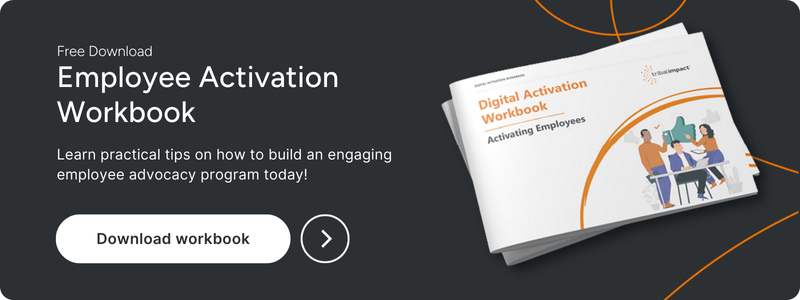In March 2024, the employee earned media value at Maximus was $7,078. Their reach was 1,502,117. This fiscal year, it’s around 6 million.
Across the globe, Maximus has around 35,000 employees. But only 200 people are in their advocacy program. This allows them to focus on driving quality – and getting results like the ones above.
Tribal chief Sarah recently spoke to Dianne Henderson, Communications Manager at Maximus, about their unique approach to employee advocacy and how they bring employee stories to life.
The Different Types of Social Media Content
Dianne explained that many people think of social as paid or organic content from branded channels.But many more tactics fall under social such as employee advocacy, executive social management, thought leadership, and brand management.
At Maximus, as part of their brand management, they aim to respond to as many comments as possible. In March 2024, they received 2300 comments and responded to 93% with a reaction or comment.
Responding to so many comments humanises the brand, lets the audience know they’re listening, and it’s good for the LinkedIn algorithm.
The algorithm wants engagement. Responding increases the reach of content and makes their audience more likely to see future content.
Shaping the Strategy
When Dianne came in, Maximus had a program, a tool, and a handful of people involved. Content was pushed to the tool sporadically and people were left to it once they had a login.
Dianne worked with her colleague to define KPIs such as getting a certain number of people involved or the activity rate.
To make it more official, she created a program guide. This allowed them to self-guide and helped train employees through the program.
You can find an example of this on her LinkedIn profile from her previous role at CareFirst BlueCross BlueShield.
Finding Quality Advocates
Dianne focused on attracting engaged employees who post on social or use it for their roles, such as recruiters or business development. She also spoke in Employee Resource Groups (ERGs).
Rather than measure the number of people involved in the program, Maximus focuses on the active rate instead. For them, it’s 77%. The average for similar programs is 59%.
For Maximus, it’s not about having thousands of ambassadors. It’s about having the right ones on the program.
ERGs vs Advocacy
Employee resource groups are relatively low effort for employees to join, so leadership often expects them to grow rapidly. The same goes for advocacy. Except rapid growth isn’t always a good thing.Dianne and Maximus have different success metrics. She wants employees to be a part of the program for the right reasons and eventually graduate from it.
Recruiting New Advocates
To recruit new people to the program, they offer training and spin it as a professional development opportunity for employees to elevate their personal brand on social.After the training, they plug the program. That’s how they get a lot of people involved.
When people understand what’s in it for them before they’re invited in, it’s more impactful than sending impersonal company-wide emails.
They also empower advocates to recruit other people. Employees get points for referring someone.
They can also request a Microsoft Teams profile that shows their advocacy level. Dianne gets a lot of questions about this, making it another great way to open up the discussion about the program in an organic way.
The Benefits of Gamification in Employee Advocacy
‘If you have gamification with a pool of advocates who are not in it for the right reasons, they’re just going to be in there pumping stuff out just to get points so that they can cash in. And it’s not authentic and the people they’re sharing their content with know that their company put them up to this,’ explained Dianne.
They have a unique way of approaching gamification and advocacy. They give points for different activities, but each activity is weighted differently.
A like on a post doesn’t count, as it’d add up too quickly. This also prepares them for when they graduate from the program and no longer get points.
Maximus also doesn’t refresh points at the end of the month. Instead, points are tallied up over time.
Different point levels equate to different ranks. For instance, hitting 250 points puts someone at the ‘Mover’ level. The names are tied to Maximus’s employer branding proposition.
Graduating from Advocacy
Maximus’s goal is that advocates can eventually graduate from gamification and do it not because of incentives, but because they believe in it and want to do it. So, they no longer need the rewards.
Dianne’s philosophy is: ‘The more points they get, the stronger the ambassador link is to the company. It’s less about points and prizes; it’s more about investment. Maybe their next journey is “help me create some of my own content,” like videos or writing blogs. At that point, they’re going to be more interested in that than points or prizes.’
Should You Give Employees Swag?
Maximus uses branded swag as a reward. Every time employees hit a new level they can pick from something. This could include caps, mug warmers, blankets, etc.
Sarah explained that gamification ‘is about more than just free Amazon vouchers.’
It’s about change management – getting them to use their account and build certain habits and behaviours.
Each month, Maximus picks an advocate of the month. To decide this, they use lots of different criteria. It’s not just about reach or engagement.
One person received it because when they ask him to comment on a post, he leaves a thoughtful comment and that’s the behaviour they want to encourage.
They also have a company-wide recognition program. The advocate of the month gets points through that too, as well as vouchers and other goodies.
Building Long-term Habits
Employees can be hugely powerful message amplifiers, making it far easier for you to reach a wider audience than if you just post from a company page.
However, it’s important to ensure employees get involved for the right reasons. Part of that involves training the right kinds of habits.
Gamification is one way you can do this, alongside offering goodies like branded swag.
Over time, employees will become invested and do the actions you want without needing the incentive, meaning they can graduate from the program while maintaining their brand-amplifying habits.

